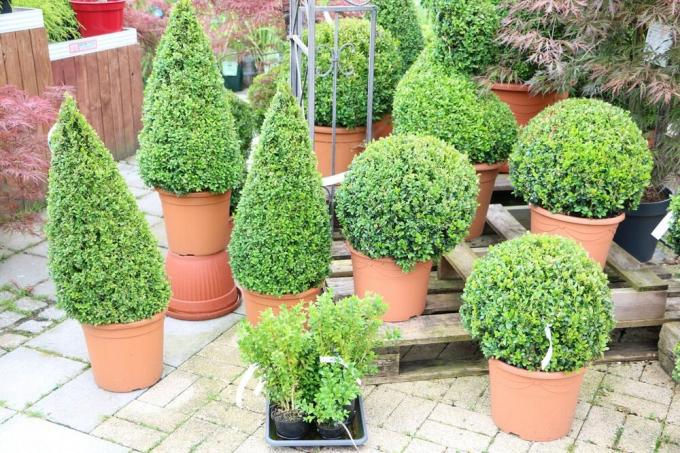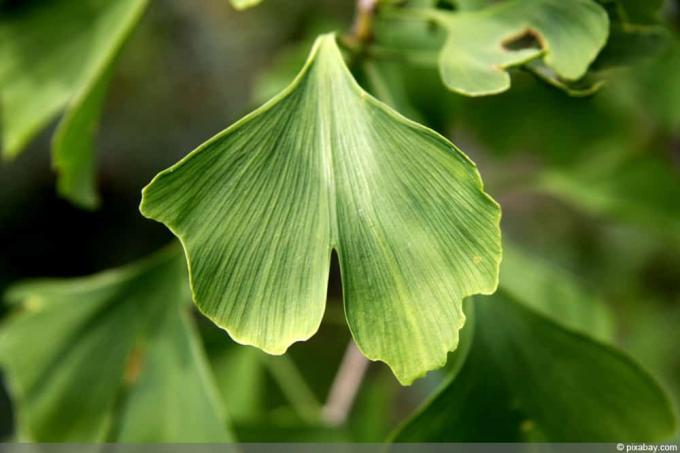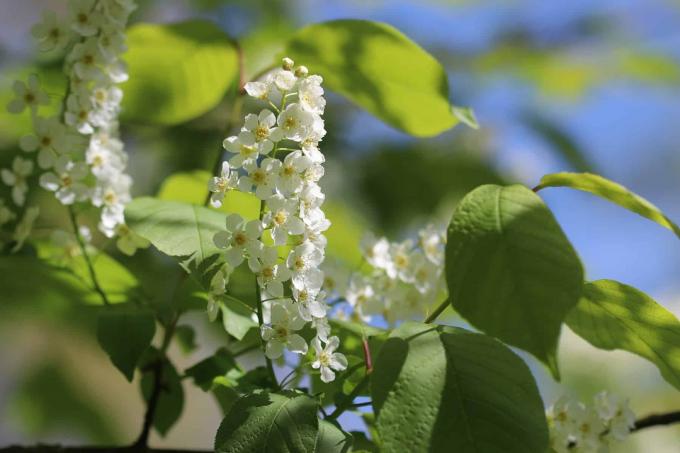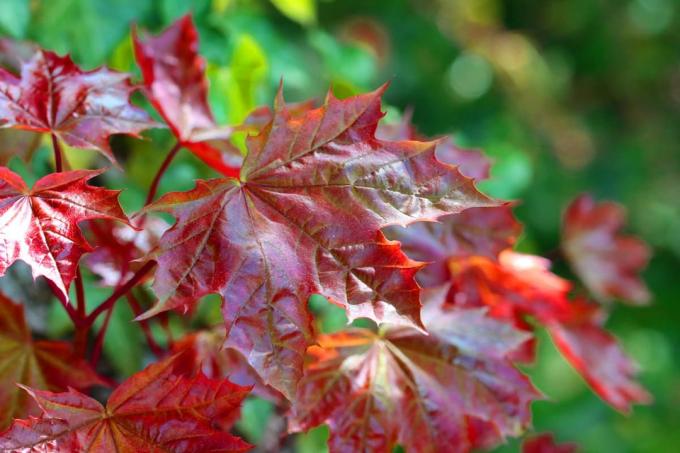

Table of contents
- boxwood
- false cypress
- Cherry Laurel Tree
- Ball Ginkgo
- Ball Locust
Evergreen spherical trees embellish the front garden all year round with a dense foliage. In addition, their growth height is limited compared to other trees, especially in the grafted forms. Since evergreen trees do not shed their leaves in the fall, caring for them and cleaning up the site are much easier to manage. Thanks to the hardy properties of the spherical trees, planting is also possible at higher altitudes.
boxwood

The boxwood bears the botanical name Buxus sempervirens and is ideal for planting in the front garden. Most types of boxwood grow very slowly, making them ideal for locations with limited space. In addition, the plant needs few nutrients compared to other trees. The Mediterranean plant is very robust and tolerates different site conditions, in extreme cases even blazing sun. If it is very warm for a long time and there is no precipitation, the boxwood is happy about an occasional shower so that the dust is washed off the leaves. However, box trees are sensitive to diseases. One harmful fungus in particular is causing the plant a lot of trouble.
- Extremely easy-care plant
- Prefers locations in the shade or semi-shade
- Ideal as an evergreen bed edging in the front yard
- Alternatively to be cultivated as a single plant in a bucket
- Can be trimmed into a living sculpture
- Perform pruning regularly
- Tolerates even extremely heavy pruning
- Forms even green leaves inside
- Fertilize with lime, iron and horn shavings
- Susceptible to fungal diseases
false cypress

The cypress bears the botanical name Chamaecyparis lawsoniana and remains green even in winter. Due to its strong growth characteristics, the coniferous tree can be easily shaped as a spherical tree, both as a solitary plant and in the background for borders in the front yard. If the pruning is missed, the extremely vigorous tree is difficult to tame. This must be carried out in a targeted manner, otherwise the wood will wilt from the inside out. Since the natural growth form tends to be taller and longer, special templates are available for the shaping pruning. The more sunshine the cypress receives at the location, the more magnificently it thrives and grows. Too much shade leads to stunted growth in the long run, and the life expectancy of the tree is also significantly reduced. In addition, the plant is very frugal in terms of care and soil.
- Needs a sunny to full sun location in a sheltered location
- Also copes with light penumbra for a while
- Fresh, humus-rich and slightly moist soil is ideal
- Doesn't tolerate lime very well
- Absolutely avoid waterlogging
- Can be easily brought into the desired spherical shape with a targeted cut
- Grows very quickly, 10 cm to 20 cm per year
- Pruning must be done frequently
- Templates for the spherical shape are available from specialist retailers
- To fertilize, work compost into the soil several times throughout the year
- Hardy, but does not tolerate extreme sub-zero temperatures
- Younger specimens look forward to additional winter protection
Cherry Laurel Tree

The evergreen cherry laurel tree is called Prunus laurocerasus in botany and is often found in domestic gardens. Alternatively, the plant is also called laurel cherry and is related to cherries and plums. The wood is often grown as a hedge because it tolerates pruning very well. As a tree, however, it grows very sprawling and can therefore be easily cut into a spherical shape. The wood fits perfectly in front gardens with a Mediterranean design, as it looks very similar to the laurel. The cherry laurel tree makes few demands on care, location and soil. The laurel cherry can also be planted under other trees, as they can deal well with competition. The deep root grows well even in the dense root network of larger neighboring trees.
- Very easy to care for ball tree
- Fast-growing shrub with strong growth potential
- Grows into a stately tree without pruning
- Older specimens reach heights of growth of up to 4 m
- Needs regular pruning in the front yard
- Shape into the desired shape at the end of June
- Bears dark green and shiny leaves
- Prefers sunny to partially shaded locations that are sheltered from the wind
- Sandy to loamy soils with fresh, moist properties are ideal
- However, does not tolerate waterlogging
- Very tolerant of lime
- Extremely frost hardy, tolerates deep sub-zero temperatures
- Seeds are poisonous to humans
Ball Ginkgo

The spherical ginkgo bears the botanical name Ginkgo biloba 'Mariken' and brings a Japanese ambience to the front yard at home with its exotic leaf shape. The wood grows very slowly and is therefore well suited for limited locations. In addition, it is robust and easy to care for, and it can also withstand the sub-zero temperatures here in winter. The crown grows by itself in a spherical shape, so special cutting measures are not necessary at the beginning to form and then maintain it. However, somewhat older specimens should already be pruned in order to bring about a targeted rejuvenation of the treetop. Since the wood develops heart roots in the depths, damage to beds and garden paths is not to be expected. Due to its resistant properties, the ball ginkgo is only slightly susceptible to infestation with pests, as well as to the outbreak of typical tree diseases.
- Grows compact and spherical
- Reaches a total height of 3 m
- Does well in sunny to shady locations
- Adapts to most soil qualities
- Soil with a high nutrient content is ideal
- Additional watering in case of prolonged drought
- Soil should never dry out completely
- Bears rather inconspicuous fruits and flowers
- Leaves form fan-like structures
- Hardy, but only deciduous
- In autumn the leaves turn bright yellow
- Wood that tolerates pruning very well
Ball Locust

The spherical black locust has the botanical name Robinia pseudoacacia "Umbraculifera" and grows quickly in height. Therefore, the plant is well suited for larger front gardens that offer it enough space. This wood is ideal when there is a desire for privacy and noise protection from the street. Over time, the trunk will continue to increase in diameter even after it has reached its full height. Over the years, the dimensions of the crown also increase, so that a periodic pruning is required. This should be cut above the grafting point, otherwise the underlay can sprout again. In this way, the desired spherical shape can continue to be maintained. The ball robinia is not very demanding when it comes to care, but freshly planted plants should be watered until they are firmly established.
- Particularly fast-growing tree
- Reaches total heights of up to 4 m
- Forms pinnate leaves with decorative autumn colors
- Foliage turns yellow, golden brown, or red in fall
- Prefers sunny and wind-protected locations
- Substrate can be dry to moist
- However, does not tolerate waterlogging, create drainage in the ground
- Does well with clay soil as well as sand and gravel soil
- Well-drained soil rich in nutrients is ideal
- Planting possible throughout the year, except on frosty days
- Fertilize with compost in spring
- Extremely compatible with cuts, can be brought into a ball shape
- Wood is very poisonous, be careful with children and pets
 garden editorial
garden editorial I write about everything that interests me in my garden.
Learn more about Baumlexikon

Bird cherry, Prunus padus: caring for, pruning & propagating
The bird cherry is a shrub or tree that is the ideal bee pasture in a natural garden. However, the plant should also be viewed with caution, as it is a poisonous plant for horses. Nevertheless, it is popular in the local colorful hedges.

Red maple: 9 tips for caring for, cutting & overwintering
The red maple is one of the most impressive trees in Germany due to its unusual scarlet leaf colour. Here you can find out how to integrate this impressive plant into your garden and how to keep it healthy and vigorous.

Sycamore tree: Properly care for and cut sycamore trees
The plane tree (Platanus) has a high decorative value. In terms of care, it is mostly undemanding, which is why it is often chosen as a street tree. Nevertheless, there are a few details to be observed when it comes to care, as described in the home garden guide.

Birch locations: 5 important criteria
Birch trees are extremely frugal trees and are particularly eye-catching and decorative thanks to their light-colored bark. When choosing a location, however, a few factors should be considered in order to create optimal conditions for their growth and to protect the environment.

Cutting dwarf pine - instructions for the perfect cut
Dwarf pines can be pruned by thinning out, topiary or limbing. A bonsai design with needle and root pruning is also possible. So that the wood does not look unattractive after the pruning measure, a few rules of technology should be observed.

Is the vinegar tree poisonous? | Who is it dangerous for?
In ornamental gardens, the vinegar tree is an attractive eye-catcher due to its unusual flowers and the appealing autumn color of its feathered leaves. The red, upright fruit cobs (flowers) are responsible for the striking appearance. Despite everything, the vinegar tree is not an unproblematic tree.
